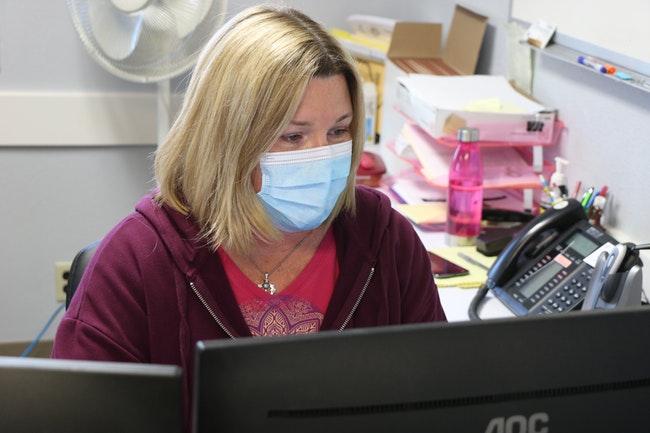
Kristie “Rae” Cooper, lead investigator with the Malheur County Health Department, works at her desk one day last week in Ontario. (The Enterprise/Liliana Frankel)
ONTARIO – Since the school year began in August, rising Covid case counts have created a logistical puzzle for nurses and administrators using careful contact tracing to minimize the number of students who need to quarantine.
Sarah Poe, Malheur County Health Department director, said that while many local public health authorities were reacting to cases in schools by quarantining whole classes or grade levels, the more labor-intensive, exact contact tracing being done in Malheur County schools is allowing for a smaller number of students to be excluded from in-person class.
That victory, however, comes at a cost for administrators who now spend, in some cases, a significant part of their day contact tracing rather than attending to their traditional educational duties. This kind of contact tracing involves calling families whose children were exposed to the coronavirus to determine how they should quarantine.
“Schools are working so hard to keep the potential for infection low by following their guidance,” Poe said. “The problem is that we just have so many cases in the community. Logistically, this is really hard, for sure.”
The most recent state data for Malheur County shows a case rate of 623 per 100,000 people, more than double the Oregon average of 244.2. The county’s adult Covid vaccination rate also lags the state goal of 80% at 45.5%, the second-worst in Oregon.
Those numbers are reflected in students and staff quarantining since the beginning of the school year in local districts – more than 70 people one week in Vale and more than 120 one week in Ontario.
Though quarantine numbers have started to go down as the community fights the surge, the Malheur County Health Department is still using surge protocols. That means that it is focusing on case investigation, which involves conversations with people who have a lab-confirmed case of Covid, rather than contact tracing, which involves conversations with people who should quarantine because they were in proximity to someone confirmed to have the coronavirus.
“What has changed in surge is that direct contact with a call every single day to every potential contact in quarantine to monitor for symptoms,” said Poe. “We do not have the capacity to do this with so many cases and it is also less effective when there is this level of community spread.”
“I feel confident saying that people should live as though they could be exposed to Covid-19 while in public,” Poe continued. “Get vaccinated, wear a mask, keep distance from those you don’t live with, move activities outside when possible, and get tested with mild symptoms or if you think you’ve had close contact with someone who is sick.”
Contact tracing in schools “is critical to preventing the spread of Covid-19, since students who are younger than 12 still can’t get vaccinated against Covid-19 because none of the vaccines have yet been approved in children in the 5-11 age group,” said Jonathan Modie, lead communications officer for the Oregon Health Authority. “Ideally, counties would be able to conduct contact tracing throughout the community, not just in schools, but for those counties with staff shortage due to the current surge, this may be difficult and, at times, not possible.”
The health department is in touch as often as twice a day with school districts to inform them of positive cases in their ranks, or identify people who need to quarantine due to a positive case in their household.
School officials then must do their own contact tracing to determine who in the school setting has been in close proximity to the affected individual, on what date, for how long, and whether they were masked, indoors, or outdoors. All of those factors, along with an individual’s vaccination status, combine to determine who is told to quarantine by the school and for what length of time.
“Having the schools put the campus close contacts in quarantine is actually more efficient at mitigating spread,” said Kristie “Rae” Cooper, lead investigator at the Malheur County Health Department. “They don’t have to wait for us to reach out to the families, and are more likely to get ahold of the parents when it is a call coming from the school, not an unknown number. They can also observe students for symptoms and determine if a shortened quarantine is applicable.”
“Where we are currently at in this pandemic, all our staff are stretched thin, so the additional burden of contact tracing is tough,” said Mark Redmond, superintendent of the Malheur Education Service District. “Our staff is doing the best they can, and keeping up as much as possible.”
“The level of community spread of Covid-19 in Oregon is placing demands across all of our systems, including education,” said Kati Moseley, Ready Schools resiliency manager for the Oregon Department of Education.
In Ontario, Malheur County’s largest school district with 2,357 students, the district has placed at least three contact tracers at each building and another 10 at the district office, said Taryn Smith, public communications and communications coordinator. The contact tracers, most of whom are district employees pulled from other duties, become certified through online training from Johns Hopkins University.
“Our primary questions (for families) revolve around the timing of contacts so that we can help them establish when the student or staff member can return to school,” said Melissa Williams, student services director for Ontario. “We also encourage students who are feeling well but are in quarantine to engage in their schoolwork via Google Classroom.”
Williams said that the district employees coordinate with health department officials regarding outside sources of contact, when to test students for possible reentry into school, and difficult decisions around quarantining larger groups of students.
Poe said that for school officials, keeping straight the dates of positive tests, symptom onsets and last contacts was crucial to their work – and could be difficult.
“The schools are monitoring that and that’s really what’s taking the bulk of their time,” she said.
Luckily, however, district officials around the county said that they felt supported by their teams and by the families they contacted, even under these trying circumstances.
“Every employee in every position is working very hard to support our students and keep in-person learning available in our district,” said Aundra DeWitt, the nurse for Nyssa School District.
“Nobody wants to be quarantined, so there is always some level of disappointment,” said Alisha McBride, the superintendent of Vale School District. “However, for the most part our families have been understanding and recognize that the quarantine requirements are not defined by the district. In most cases, students are able to end their quarantine early with a negative Covid-19 test five to seven days after exposure, so this option can help decrease the length of the quarantine.”
“This work is vital to the health of our staff and students and our ability to keep our schools open,” said Williams. “There is no question that it can be exhausting, but the positive supportive reactions we are getting from most of our families is re-affirming. I heard one of our tracers say ‘it has restored her faith in humanity.’”
News tip? Contact reporter Liliana Frankel at [email protected] or 267-981-5577.
EXCELLENCE IN JOURNALISM – Available for $5 a month. Subscribe to the digital service of the Enterprise and get the very best in local journalism. We report with care, attention to accuracy, and an unwavering devotion to fairness. Get the kind of news you’ve been looking for – day in and day out from the Enterprise.




